|
|
||||||||||||||||||||||||||||||||||||||||||||||||||||||||||
|
Please sign my Guestbook and leave feedback |
||||||||||||||||||||||||||||||||||||||||||||||||||||||||||
|
Recent Additions |
||||||||||||||||||||||||||||||||||||||||||||||||||||||||||
|
The joy of English parish churches is their sheer variety. A thousand years of changing fashions, architectural innovation, liturgical change and endless interventions by patrons has ensured that no two churches are remotely identical. Yet, each region of the country displays idiosyncrasies in its churches. In the West Country, for example, they favour bowed “waggon roofs” that you will see hardly anywhere else. The round tower churches of Norfolk and Suffolk are sufficiently recognised to have a society dedicated to them. Those “regions”, of course, do not follow ancient or modern county boundaries nor even necessarily the vaguer modern regional designations such as are used, for example, by TV companies. A mason would not have recognised the word “Midlands” let alone “East Midlands”. Who or what, then, created these variations? Often it was down to local materials. The round tower churches of Norfolk and Suffolk, for example, are believed to be the result of non-availability of local quarry stone for the corners of square towers. Stylistic or decorative preferences are less easy to explain within a geographical context but one factor is paramount: the availability of suitable stone. Many types of stone are totally unsuitable for sculpture. The granite used in many Cornish churches, for example, is so hard that sculpture is a rarity. The lovely white stone quarried underground in Beer in Devon was also sculpted underground because once it had been exposed to the warmer air outside it became too hard. The Normans were so unimpressed with the suitability of some English stones that they imported a lot from their native Caen at vast expense. Norwich Cathedral in stone-starved Norfolk imported stone from Barnack near Peterborough at enormous cost. This tiny village had the distinction of providing stone for three English cathedrals. If stone that is easy to carve is almost non-existent in Cornwall in the East Midlands there is a super-abundance. It lies in part on the so-called “Limestone Belt”. I have already made mention of Barnack – which is long-exhausted – but even now there are numerous working quarries in the area at places such as Clipsham and Holywell. |
|||||||
 |
 |
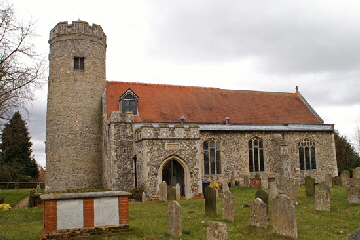 |
|||||
|
Left: Arcade capital in Beer stone at Colyton, Devon. Centre: Triple waggon roof church at Altarnun, Cornwall. Right: Round tower church, Bungay, Suffolk |
|
It is, perhaps, too easy to fall back on “fashion” as an explanation for regional variations. In the absence of mass media fashions would be very localised. It is true that wealthy patrons would be expected to have had broader horizons – and they were desperately aware of fashions in costume - but after the great plagues of the second half of the fourteenth century it was the parish that was increasingly the patron of the local church, not the manorial lord. By this time most parish churches were built. Very occasionally a church might be completely rebuilt but the tendency was towards expansion of what was already there. In an atmosphere of terror of the after-life aristocratic patronage was increasingly focused on the preservation of immortal souls through the building of chantry chapels – themselves frequently leading to the expansion of an aisle. Then there was the important issue of showing family status through the commissioning of grand funerary monuments. The notion of the better-travelled members of society influencing church building through their knowledge of architectural fashion is then, perhaps, a little fanciful. It was more a case of emulation. |
||||||
 |
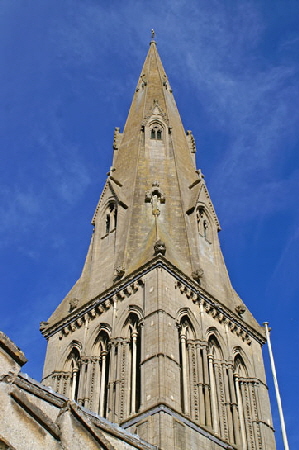 |
|||||
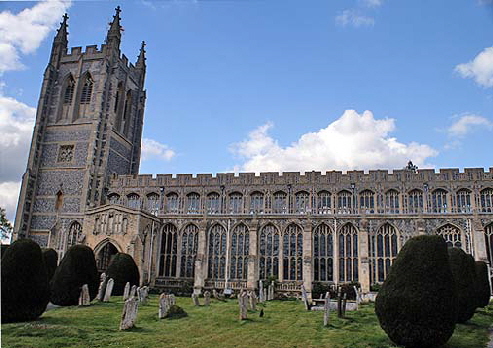 |
||||||
|
Left: Early English Tower, St Mary’s Church, Stamford, Lincs. Centre: Early English Tower - a “Rutland Bruiser” - Ketton, Rutland, 3 miles from Stamford Right: Wool Merchant Largesse: Holy Trinity Church, Long Melford, Suffolk. |
|
Exactly who in any given area set the precedent that other churches felt bound to follow can never be established. We cannot know where the first Rutland Bruiser tower was built and whose idea it was. Perhaps it was St Mary’s Church in the important mediaeval town of Stamford (ironically just outside the boundaries of Rutland)? Who then decided to build a second at, say, Ketton or Ryhall? These may seem hypothetical questions but they are not. Whoever built that first tower got the idea from somewhere, we know not where; but they had to have the masons who were able to execute that vision. Believe me, if you visit St Mary’s Stamford and see how large that tower is and how steep is the hill upon which it has stood for over eight hundred years you will understand that “feasibility” and “capability” would be high on your list of discussion points if you were to think of building something similar! Those emulating that tower elsewhere in the area faced smaller geophysical challenges but capability would still have been a cardinal issue. It is unlikely that the masons would have toured Rutland building a series of these structures so the chances are that the necessary knowledge was passed from mason to mason, generation to generation. Today we would write text books. Nobody believes that there were church-building manuals in the thirteenth century (or, at any rate, not for parish church masons). The knowledge was almost certainly vested in the masons, not in the patrons nor in the clerical hierarchy. If you wanted a tower like Stamford’s you had to hope you could find masons who knew how to do it or who had the confidence to suck it and see. |
|||
 |
|||
|
Sculpted Cornice Friezes South Aisle and Clerestory, St Andrew Church, Whissendine, Rutland. Note the stylistic differences between the two friezes, that on the clerestory being much the more vibrant. Also on the clerestory, note the “mooning” exhibitionist extreme left and unidentifiable creature (a flea? a louse?) to its right. Note also the elaborate gargoyles and the battlemented parapets. |
|||
|
The area of principal interest is shown in the map below. When looking at the distribution of the sites of major significance to this study it is striking how closely they are located. From Tilton-on-the-Hill in Leicestershire at the extreme south of the area to Muston in the north is a crow’s flight distance of twenty miles. From Hungarton in the west to Ryhall in the east is about the same distance. Some eighty percent of the significant sites are contained within a roughly triangular area of about thirty square miles bounded by Hungarton, Buckminster and Exton. As we begin to identify trademark carvings and individual styles of carving this density of sites will be of compelling interest. |
|||
 |
|
Of course the area is not defined by administrative geography at all but by the extent of demand for the work and the availability of the appropriately skilled labour to supply it. Of these two factors it is the latter which is the deal-breaker. If a church needed extending then the wish for decoration was hardly likely to be the most important consideration to the parish patrons and would not justify a long delay until the “right” mason was found. If masons, on the other hand, were to offer decoration then a parish would balance the extra cost of such a frippery against their sense of pride and desire to emulate. As we proceed with this study it will become very clear that all of this decoration was probably driven by the stonemasons’ ability to supply something that the patrons valued. What, though, is a church frieze? For the purposes of this account it is a length of decorative carved sculpture. It forms the cornice at the junction between wall and roof. The cornices are long and so they are, of course, formed of many smaller lengths and on each length there might be between one ir two carvings and very occasionally three. Because they were constructed piecemeal it is clear that in places the planning went awry and the spacing of the sculptures was a little irregular. |
||
 |
||
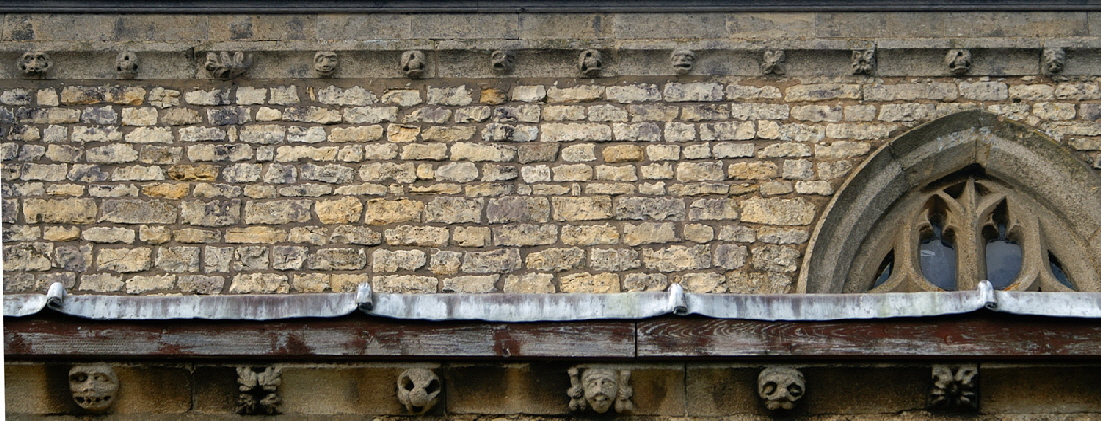 |
||
|
Top: One of the most celebrated Norman corbel tables in England on one of the finest Norman churches: St Mary and St David, Kilpeck, Herefordshire. Bottom: Carved friezes on the the south aisle and south clerestory, St Nicholas Church, Cottesmore, Rutland. |
||
|
Just as a gargoyle has a function – that of draining water from the roof whereas a grotesque does not - so a corbel table is functional; but a cornice frieze is not. They are also structurally quite different. A corbel needs to be part of the wall itself in order to function as a support. A frieze is usually attached to the wall almost as an afterthought. |
 |
|
|
|
Nor was the tradition revived during the Victorian period. Kendal in Cumbria is the only one I can really think of. True, there are places where old friezes have been patched up, gaps filled in and so on. Whereas, however, big town churches quite like to put up faux mediaeval gargoyles and the odd carving as a kind of “right on” gesture towards the past, church friezes such as those at Cottesmore are seemingly consigned to mediaeval history. |
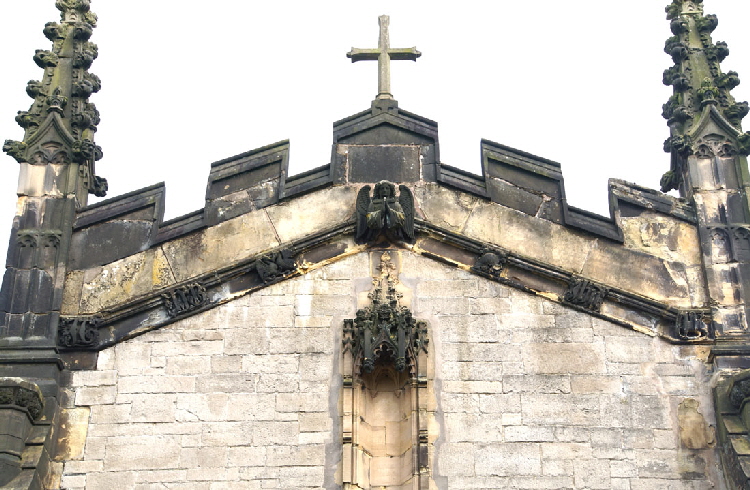 |
||||||
|
A rare Victorian revival of a mediaeval decorative tradition. Sculpted cornice frieze, Holy Trinity Church, Kendal, Cumbria. Note also the beastie figures on the pinnacles. |
||||||
|
Recommended Next Section: The Gargoyle Master |
||||||
|
Friezes - a Local Speciality (you are here!) Church Building in the Post-Plague Era |
||||||
